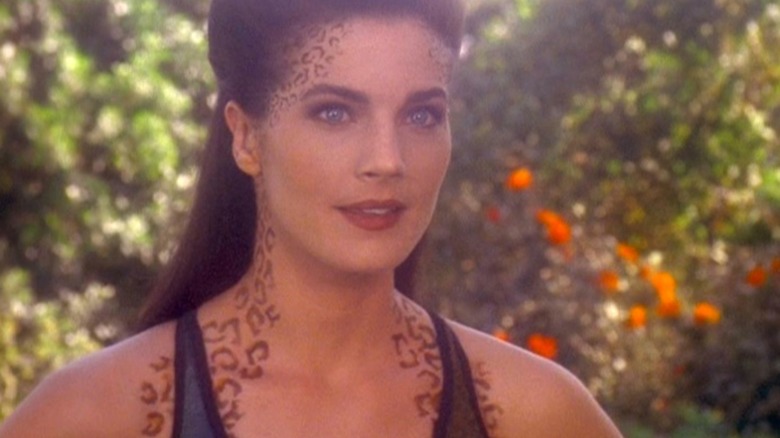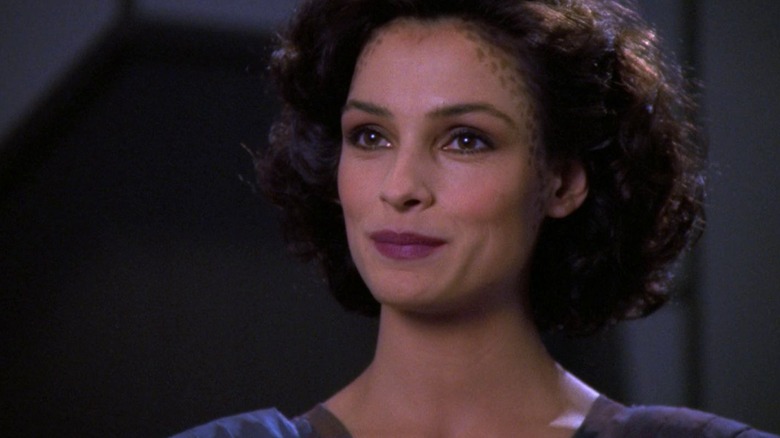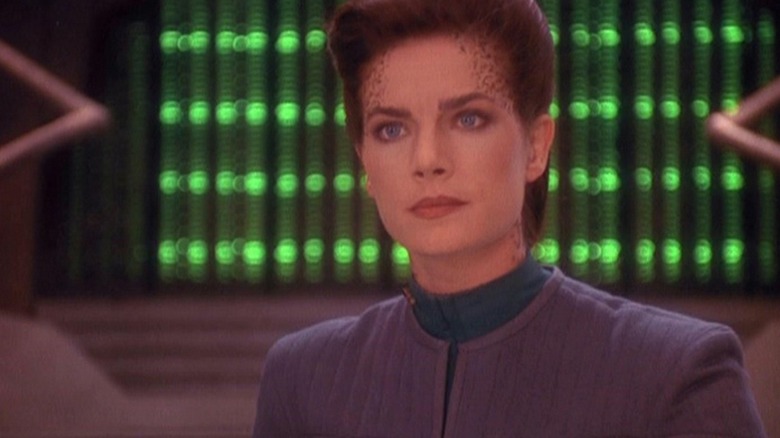Why Star Trek's Trill Mysteriously Sprouted Spots When It Came Time For Deep Space Nine
The Trill were first introduced in the "Star Trek: The Next Generation" episode "The Host" (May 11, 1991). In that episode, Dr. Beverly Crusher (Gates McFadden) engaged in an intense love affair with a Trill super-diplomat named Odan (Franc Luz), a man whom she later discovered had a very unusual biology. It seems some members of the Trill species are joined with incredibly long-lived worm-like symbionts that are surgically implanted in their stomachs. The symbionts possess the memories and experiences of all their hosts and take over the personalities of the people they are implanted inside of. Symbionts can live through dozens of hosts in their lives.
In "The Host," Odan sported inverted v-shaped forehead ridges above his eyes and a larger, extended septum. The makeup was designed by Michael Westmore, a longtime "Next Generation" makeup artist.
It wouldn't be until "Emissary" (January 3, 1993), the pilot episode of "Star Trek: Deep Space Nine," that Trekkies would encounter another Trill. "DS9" featured a Trill character named Jadzia Dax (Terry Farrell), who served as Deep Space Nine's science officer. In the lore of the series, Jadzia had recently been given the Dax symbiote after it spent many decades inside the body of a party-loving old man named Curzon. Jadzia had to reconnect with several old friends who knew her from her previous life.
Dax, one might immediately note, doesn't have the same forehead ridges that Odan did. It seems that the makers of "Deep Space Nine," after trying out similar ridges on Farrell, elected to do something less obtrusive. According to Paula M. Block's and Terry J. Erdmann's book "Star Trek: The Next Generation 365," Dax's makeup artists modeled her new "spots" after Westmore saw how good they looked on Famke Janssen in the "Next Generation" episode "The Perfect Mate" (April 27, 1992).
Famke Janssen, the perfect mate
Resourceful Trekkies can likely find the early makeup tests that Terry Farrell went through for "Deep Space Nine." It seems that the original Dax makeup design was to give her Odan's forehead ridges but to make them less pronounced. The reason for a more "subtle" version of the makeup was likely twofold. For one, the series already featured numerous alien characters that required hours-long makeup jobs, and having one fewer was cheaper. It's also likely that someone didn't want the actor's face covered. According to the "365" book, the studio in particular didn't want an attractive actor like Farrell to sport a weird alien forehead. A redesign of the Trill makeup was required.
Westmore recalled doing makeup for "The Perfect Mate" and was inspired. In that episode, a woman named Kamala (Famke Janssen) is being transported in stasis to a diplomatic summit where she will offered as a bartered bride. Kamala's arranged marriage with a distant politician will, it is hoped, end a generations-long war. Naturally, Kamala — having been released from stasis early by accident — accidentally bonds with Captain Picard (Patrick Stewart). Kamala was depicted as being romantically and sexually irresistible, and her makeup was meant to reflect that. Westmore was fond of her look, which incorporated a series of small red spots on Kamala's temples.
That look was recreated for Dax and even expanded. Dax had a complex series of spots that ran down her temples and down her neck. A flirtatious alien once asked Dax how far down the spots go, and she winkingly replied, "All the way."
The new Trill look worked well. It denoted that she was an alien, but more subtly than the show's Changeling or Ferengi characters.
The continuity headache
Sadly, the new makeup design caused no small amount of headaches for Trekkies obsessed with continuity (which is to say, most Trekkies). In "The Host," both Odan and the eventual second host of his symbiont (played by actor Nicole Orth-Pallavicini) had the ridged forehead and pronounced septums. After that, all Trill had the temple spots, even into the days of "Star Trek: Discovery." There has never been a canonical reason for the change, and no characters have ever commented that Trill used to look different.
It is, frustratingly, just another changed "Star Trek" premise that fans merely have to accept. For many years, for example, Klingons looked like humans, only sporting Fu-Manchu-style mustaches. In "Star Trek: The Motion Picture," they suddenly had outsize forehead ridges. In "Next Generation," their foreheads were enormous, and in "Discovery," they sported either jet-black or pearl-white skin, elongated skulls, new eyeballs, and even extra nostrils. These kinds of changes are done for the benefit of the showrunners' creativity and typically serve to make fans squirm uncomfortably. Something similar happened with the Romulans as they moved from the original "Star Trek" to the days of "Next Generation."
Of course, with the Klingons, their change was eventually addressed. A multi-part episode of "Star Trek: Enterprise" explained that the "Original Series" Klingons were infused with enhanced human DNA. That DNA would eventually be bred out of Klingons in a few generations, hence they looked the way they did in "Next Generation."
Given the attention to detail some "Trek" writers pay, it's likely a future episode will explain away the Trill foreheads in earnest.


